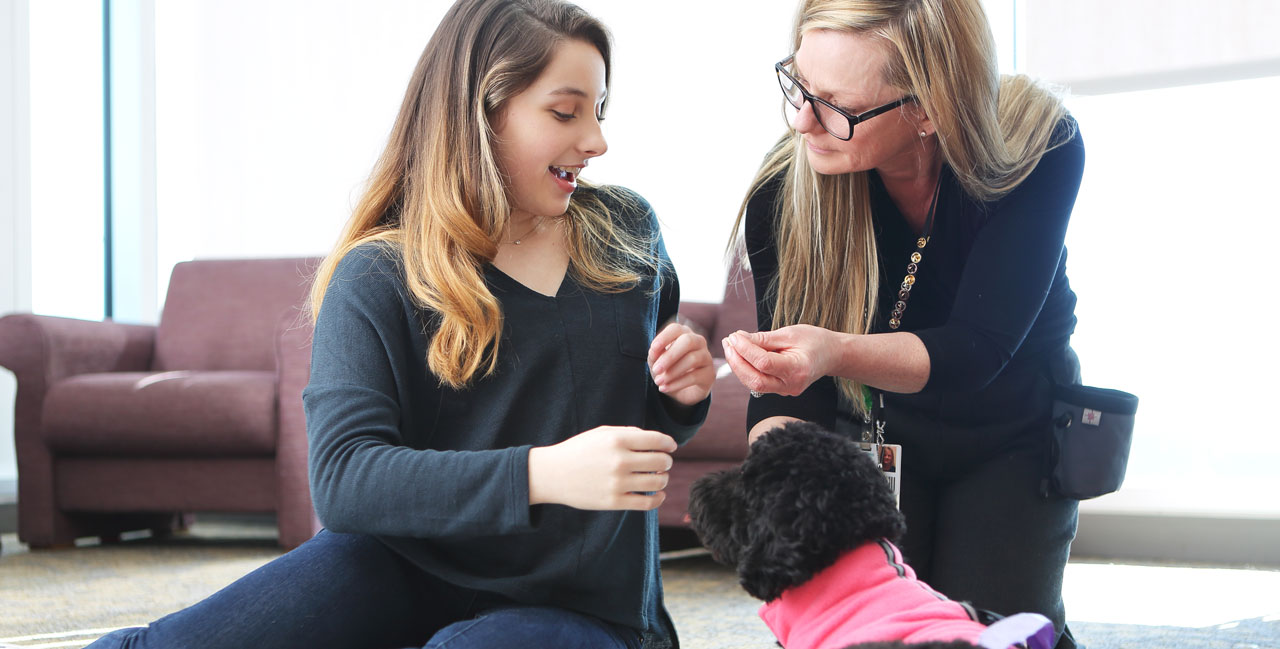Pictured above: Lisa Steinhilber, EdS, LPC, ACS (right) and Sadie partner to provide animal-assisted therapy for patients.
Sadie is part of Penn Medicine Princeton House Behavioral Health’s new Animal-Assisted Therapy Program, a goal-directed intervention that launched with the Hamilton outpatient site and is slated to expand throughout the outpatient locations as part of the Child and Adolescent Program.
“Penn Medicine Princeton Medical Center offers pet therapy as a beneficial volunteer service that contributes to healing,” explains Jody Kashden, PhD, Clinical Director of the Child and Adolescent Program at Princeton House. “Our Animal-Assisted Therapy Program at Princeton House goes deeper to provide a more targeted intervention for outpatients receiving behavioral health services. Therapy is delivered by behavioral health professionals with specialized expertise, and animal partners are trained to meet specific criteria in supporting treatment goals.”
Sadie understands the term “go be mindful,” a cue that means she will return to her designated place to rest. She also has a unique intuition; she senses which patients need her the most, and stays by their side until they are feeling less anxious.
“Often our patients step into the world each day worried about being judged,” says Lisa Steinhilber, EdS, LPC, ACS, Animal-Assisted Therapy Clinician at Princeton House and Sadie’s partner. “A dog or pet has the ability to drop barriers and create an atmosphere of safety much more quickly than a human does. It’s an honoring moment when I bring Sadie into the room.”
Maximizing Engagement
Animal-assisted therapy is an important addition to other Princeton House allied therapies, like art and music, with a curriculum that is part of the treatment plan.
“Princeton House is an innovator in providing this clinician-led therapy in a behavioral health setting,” says Dr. Kashden. “Research shows that it can facilitate treatment gains. Specifically, we’ve found that the partnership and involvement of therapy dogs in our treatment applications helps us to engage patients and improve their ability to work on treatment goals.”
“It can be particularly beneficial for children, who aren’t usually the ones making the decision to be in therapy,” she adds. “Animal-assisted therapy creates a safer space more quickly and a foundation we can build on, allowing us to maximize therapy time and enabling them to engage at an optimal level.”
|
The Animal-Assisted Therapy Program at Princeton House is designed to improve adjustment and adaptive functioning while decreasing behavioral health problems. Behavioral health literature cites a number of benefits for patients, including:
|
Article as seen in the Winter 2018 issue of Princeton House Behavioral Health.



